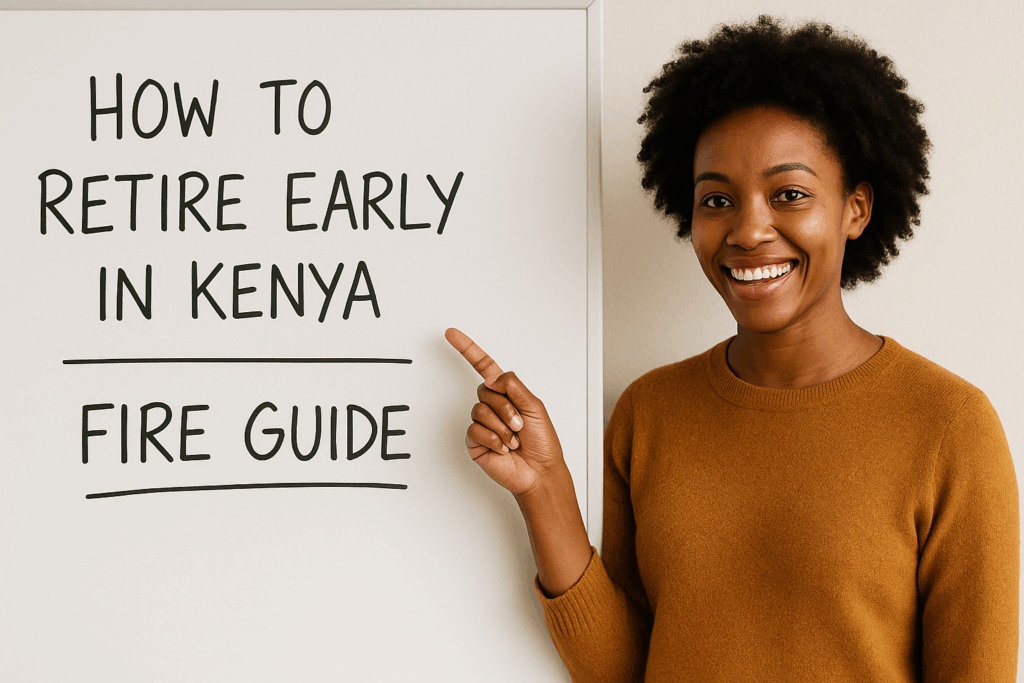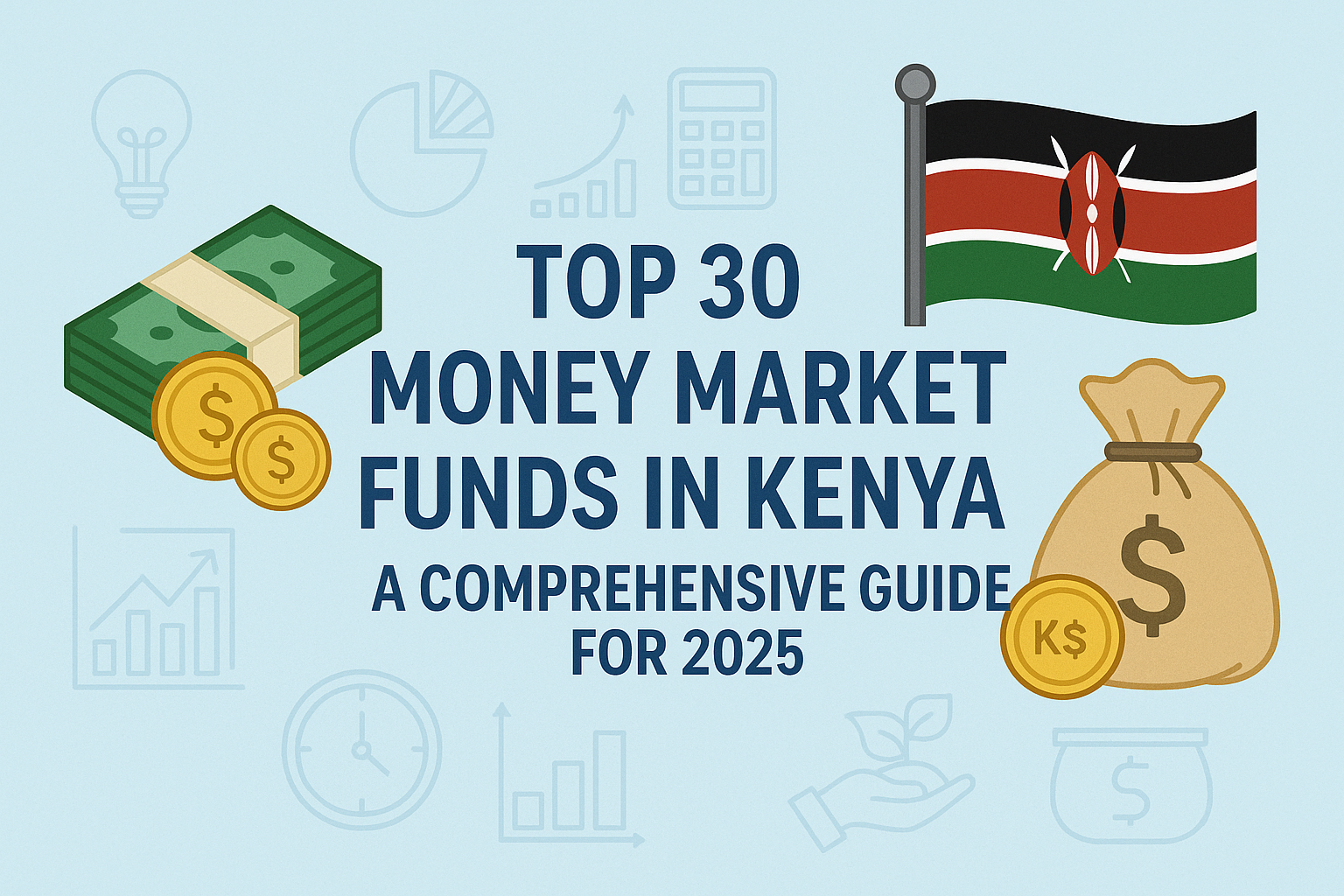Is Early Retirement a Kenyan Dream or Reality?
In Kenya, many people believe retirement is something you wait for until 60 or 65. But in 2025, more Kenyans — especially millennials and Gen Z professionals — are exploring the FIRE movement (Financial Independence, Retire Early).
FIRE means saving and investing aggressively so that you no longer depend on a paycheck. Once your passive income covers all your living expenses, you can retire early or work only because you want to, not because you have to.
But can FIRE work in Kenya where inflation is high, salaries are limited, and financial obligations extend to family and community (“black tax”)? The answer is yes — but with adjustments tailored to the Kenyan context.
Step 1: Understand the FIRE Movement
There are different FIRE models:
- Lean FIRE – Retiring early with a frugal lifestyle, spending very little.
- Fat FIRE – Retiring early with luxury and comfort, requiring a big portfolio.
- Barista FIRE – Retiring early from formal jobs but still doing light work, side hustles, or part-time business.
- Coast FIRE – Saving and investing heavily in your 20s–30s, then letting investments grow while working less stressful jobs later.
👉 For Kenya, Lean FIRE and Barista FIRE are most realistic for middle-income earners, while Fat FIRE is more common among high earners and diaspora Kenyans investing back home.
Step 2: What’s Your FIRE Number in Kenya?
Your FIRE number = 25 × your annual expenses.
If you need KES 1M a year, you must save/invest KES 25M to retire early safely.
Examples in Kenya:
- Urban professional (Nairobi):
- Monthly expenses: 120K
- Annual: 1.44M
- FIRE number: 36M
- Middle-class family (Nakuru):
- Monthly expenses: 70K
- Annual: 840K
- FIRE number: 21M
- Frugal retiree (Rural Kitale):
- Monthly expenses: 30K
- Annual: 360K
- FIRE number: 9M
👉 The lower your expenses, the lower your FIRE target. This is why many Kenyans aim to retire in affordable towns or rural areas.
Step 3: Track & Cut Expenses — The Lean FIRE Advantage
You cannot FIRE without controlling expenses.
Kenyan-specific expense reductions:
- Housing: Move from Nairobi to satellite towns (Kitengela, Ruiru, Rongai).
- Food: Buy wholesale at Marikiti or Gikomba instead of supermarkets.
- Transport: Use matatus or SGR instead of frequent flights and Ubers.
- Entertainment: Replace costly clubs with affordable family outings.
- Education: Use public schools or affordable private schools instead of expensive academies.
If you cut KES 20,000 per month, that’s KES 240,000/year saved — which shortens your FIRE journey by years.
Step 4: Grow Your Income — The Kenyan Hustler’s Way
Expense cutting alone isn’t enough. You must increase income.
Kenyan income boosters:
- Freelancing: Writing, coding, design on Upwork/Fiverr.
- Digital content: YouTube, blogging, TikTok (many Kenyans now earn >100K/month).
- Small business: Mitumba, beauty, boda boda, car hire.
- Consulting: Many professionals consult after hours.
- Diaspora side hustle: Kenyans abroad can remit part of their income into MMFs, SACCOs, or land.
Goal: Save 50–70% of your income.
Example:
- Earn 150K, live on 50K, save 100K = 1.2M/year.
- In 15 years (invested at 10% annually), that grows to over 30M.
Step 5: Choose FIRE-Friendly Investments in Kenya
1. Money Market Funds (MMFs)
- Return: 10–12% per year
- Low entry: from 500 shillings
- Examples: Zimele, Cytonn, Sanlam, Nabo Capital
- Perfect for emergency fund + short-term FIRE savings
2. SACCOs
- Dividends 6–12%
- Loan access for real estate projects
- Examples: Stima SACCO, Safaricom SACCO, Mwalimu SACCO
3. NSE Dividend Stocks
- Safaricom, Equity, KCB, Co-op Bank
- Long-term growth + annual dividends
4. Treasury Bonds & Bills
- Government-backed, safe
- Returns: 9–16% depending on maturity
5. Real Estate & Airbnb
- Build rentals in satellite towns or student areas
- Airbnb in Nairobi, Mombasa, Naivasha
6. Digital Assets
- Blogs, YouTube, online courses, e-books
- Once built, they earn passively for years
Step 6: Build Multiple Income Streams
Don’t depend on one. A strong Kenyan FIRE plan mixes:
- KES 2M in MMFs = 220K annual
- KES 5M in rentals = 600K annual
- KES 3M in stocks = 300K annual
- Digital content = 20K/month = 240K annual
Total = 1.36M per year passive income.
That can comfortably support Lean FIRE in most towns in Kenya.
Step 7: Retirement Planning for Families
Couples:
- Combine incomes and split savings goals.
- One partner can cover essentials while the other focuses on investments.
Families with children:
- Add education costs into your FIRE number.
- Consider education insurance or specific school savings plans.
Single Kenyans:
- Easier to FIRE if frugal.
- But must plan for medical and elder care.
Step 8: FIRE by Location — Where to Retire in Kenya
- Nairobi FIRE – Needs Fat FIRE (high cost of living).
- Mombasa FIRE – Relaxed lifestyle, affordable housing.
- Nakuru/Eldoret/Kisumu FIRE – Affordable + good infrastructure.
- Rural FIRE – Cheapest, but needs land ownership.
👉 Example: A Nairobi lifestyle needs 100K/month (36M FIRE number). A Nakuru lifestyle might only need 50K/month (18M FIRE number).
Step 9: Risks & Challenges of FIRE in Kenya
- Inflation – Food and fuel prices rise fast.
- Black tax – Supporting relatives slows your savings.
- Scams – Ponzi schemes and fake “investment clubs.”
- Unemployment shocks – Risk of job loss before hitting FIRE.
- Medical emergencies – A single illness can wipe out savings.
Step 10: Step-by-Step Roadmap (Kenyan Example)
Case: Middle-class Nairobi family (income 200K/month).
- Year 1–5: Save 70K/month (840K/year). Build emergency fund, join SACCO, start MMF.
- Year 6–10: Invest in NSE, buy land, build rentals. Savings + investments grow to 10M+.
- Year 11–15: Expand rental units, add digital side hustle income. Portfolio reaches 30M.
- Year 15: Passive income 3M/year = FIRE achieved.
Case Studies of Kenyans on FIRE Path
- Brian (IT professional, 32): Saves 50% of salary in MMFs + stocks. Plans to FIRE at 45 in Nakuru.
- Mary (Teacher, 40): Built 8 rental bedsitters in Kisumu. Already covering 60% of expenses passively.
- Diaspora Kenyan Couple (UK): Invested in treasury bonds + land in Naivasha. Expect to return and FIRE at 50.
FAQs on FIRE
Q1: How long will it take to FIRE in Kenya?
- Saving 20% = 30+ years
- Saving 50% = 15 years
- Saving 70% = 8–12 years
Q2: Can low-income Kenyans FIRE?
Yes — Lean FIRE in rural areas is achievable with small consistent savings + SACCO membership.
Q3: Should I pay off debt first or save for FIRE?
Pay off high-interest debt (mobile loans, credit cards) while saving at least 10%.
Q4: How do I protect my FIRE savings?
Diversify between MMFs, SACCOs, bonds, real estate, and stocks. Avoid “all eggs in one basket.”
Q5: Is FIRE realistic with Kenya’s inflation?
Yes, but your FIRE portfolio must grow faster than inflation (target 10–15% annual return).
Conclusion: Can You Really FIRE in Kenya?
Yes. Early retirement in Kenya is possible if you:
- Track and reduce expenses.
- Save aggressively (50–70% of income if possible).
- Invest in FIRE-friendly assets (MMFs, SACCOs, bonds, rentals, stocks).
- Build multiple income streams.
- Plan for risks (inflation, medical bills, black tax).
FIRE is not just about quitting work — it’s about having the freedom to choose how you spend your time. Whether you want to run a small farm in Naivasha, blog in Mombasa, or live quietly in Kisii, FIRE gives you the financial independence to design your life.
The best time to start was yesterday. The second-best time is today.


